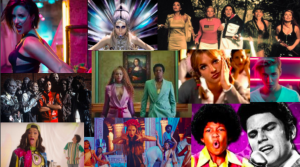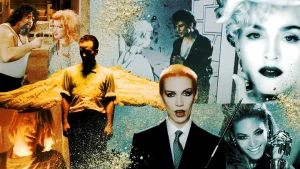
Introduction
Music videos have undergone a remarkable transformation since their inception, evolving in tandem with technological advancements and cultural shifts. This article delves into the fascinating journey of music videos, tracing their evolution from the early days of MTV to the modern era dominated by YouTube.
The Birth of Music Videos

-
Early Experiments and Pre-MTV Era
The concept of music videos can be traced back to the early 20th century, with the advent of sound films and “talkies.” Short musical films, known as “soundies,” were produced in the 1940s, featuring artists performing their songs. These early experiments laid the groundwork for the music video format we recognize today.
-
The MTV Revolution
The launch of MTV (Music Television) on August 1, 1981, marked a pivotal moment in the history of music videos. MTV’s 24-hour music video programming revolutionized the music industry, providing a platform for artists to visually express their music. The iconic debut of “Video Killed the Radio Star” by The Buggles signaled the beginning of a new era.
-
Impact on the Music Industry
MTV’s influence on the music industry was profound. Music videos became essential for promoting singles and albums, and artists began to invest heavily in high-quality, visually captivating productions. The channel’s popularity also gave rise to the VJ (video jockey) culture, with personalities like Martha Quinn and Kurt Loder becoming household names.
-
Iconic Music Videos of the MTV Era
Several music videos from the MTV era have left an indelible mark on popular culture. Michael Jackson’s “Thriller,” directed by John Landis, is often hailed as the greatest music video of all time. Madonna’s “Like a Prayer,” with its provocative imagery, sparked controversy and debate. These videos, among others, showcased the potential of music videos as a powerful storytelling medium.
The Digital Revolution: The Rise of YouTube
The launch of YouTube in 2005 brought about a seismic shift in the way music videos were consumed and distributed. Founded by Steve Chen, Chad Hurley, and Jawed Karim, YouTube provided a platform for users to upload, share, and view videos, democratizing content creation and distribution.
Impact on Music Videos

YouTube’s impact on music videos was immediate and far-reaching. Artists no longer needed the backing of major record labels or MTV to reach a global audience. Independent musicians and emerging artists could now showcase their work to millions of viewers with just a few clicks. This democratization of content led to an explosion of creativity and diversity in music videos.
-
Viral Sensations and Internet Culture
The rise of YouTube gave birth to the phenomenon of viral videos. Music videos like Psy’s “Gangnam Style” and Luis Fonsi’s “Despacito” shattered records, garnering billions of views and becoming cultural phenomena. These viral sensations demonstrated the power of the internet to propel artists to global stardom.
-
The Role of Social Media
Social media platforms like Facebook, Twitter, and Instagram played a crucial role in the dissemination of music videos. Artists and fans alike could share and promote videos, creating a sense of community and engagement. The integration of music videos into social media feeds further amplified their reach and impact.
The Evolution of Music Video Production

-
Technological Advancements
The evolution of music videos has been closely tied to advancements in technology. High-definition cameras, computer-generated imagery (CGI), and sophisticated editing software have revolutionized the production process. These tools have enabled artists to create visually stunning and conceptually ambitious music videos.
-
The Role of Directors and Collaborations
Directors have played a pivotal role in shaping the evolution of music videos. Visionary directors like Spike Jonze, David Fincher, and Hype Williams have pushed the boundaries of the medium, creating iconic and innovative videos. Collaborations between artists and directors have resulted in some of the most memorable music videos in history.
-
The Emergence of Interactive and Virtual Reality Music Videos
The advent of interactive and virtual reality (VR) technology has opened up new possibilities for music videos. Interactive videos, where viewers can choose different storylines or camera angles, offer a more immersive experience. VR music videos, such as Björk’s “Stone milker,” allow viewers to step inside the video and experience it from a 360-degree perspective.
The Future of Music Videos

-
The Continued Influence of Streaming Platforms
Streaming platforms like YouTube, Vevo, and TikTok will continue to play a dominant role in the distribution and consumption of music videos. These platforms provide artists with unparalleled access to a global audience and offer new opportunities for monetization and engagement.
-
The Integration of Artificial Intelligence and Augmented Reality
The integration of artificial intelligence (AI) and augmented reality (AR) into music video production holds exciting potential. AI can be used to create personalized and adaptive music videos, while AR can enhance live performances and create immersive experiences for viewers.
-
The Role of Fan Engagement and Participation
Fan engagement and participation will continue to shape the evolution of music videos. Crowd sourced content, fan-made videos, and interactive experiences will foster a deeper connection between artists and their audiences. The collaborative nature of the internet will drive innovation and creativity in music video production.
Conclusion
The evolution of music videos from the early days of MTV to the digital age of YouTube has been a remarkable journey. Technological advancements, cultural shifts, and the democratization of content have transformed music videos into a powerful and dynamic medium. As we look to the future, the continued influence of streaming platforms, the integration of AI and AR, and the role of fan engagement will shape the next chapter in the evolution of music videos.










